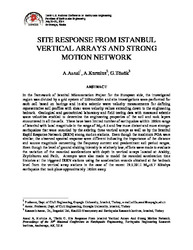Site response from Istanbul vertical arrays and strong motion network
| dc.contributor.author | Ansal, Mustafa Atilla | |
| dc.contributor.author | Kurtuluş, Aslı | |
| dc.contributor.author | Tonuk, G. | |
| dc.date.accessioned | 2016-02-17T11:05:48Z | |
| dc.date.available | 2016-02-17T11:05:48Z | |
| dc.date.issued | 2014 | |
| dc.identifier.isbn | 9781634397797 | |
| dc.identifier.uri | http://hdl.handle.net/10679/2902 | |
| dc.identifier.uri | https://www.eeri.org/products-page/national-conference-on-earthquake-engineering/10th-u-s-national-conference-on-earthquake-engineering-frontiers-of-earthquake-engineering-proceedings-thumb-drive/ | |
| dc.description.abstract | In the framework of Istanbul Microzonation Project for the European side, the investigated region was divided by a grid system of 250m×250m and site investigations were performed for each cell based on borings and in-situ seismic wave velocity measurements for defining representative soil profiles with shear wave velocity values extending down to the engineering bedrock. Geological and geotechnical laboratory and field testing data with measured seismicwave velocities enabled to determine the engineering properties of the soil and rock layers encountered in all the cells. There have been limited number of earthquakes within 100km range of Istanbul with local magnitude in the range of ML=4-5 and few more distant and more stronger earthquakes that were recorded by the existing three vertical arrays as well as by the Istanbul Rapid Response Network (IRRN) strong motion stations. Even though the maximum PGA were similar, the observed spectral response were different indicating the importance of the distance and source magnitude concerning the frequency content and predominant soil period ranges. Even though the level of ground shaking intensity is relatively low, efforts were made to evaluate the variation of the recorded accelerations with depth in vertical arrays located at Ataköy, Zeytinburnu and Fatih. Attempts were also made to model the recorded acceleration time histories at the triggered IRRN stations using the acceleration records obtained at the bedrock level from the vertical array stations in the case of the recent 19.5.2011 Mw=5.7 Kütahya earthquake that took place approximately 185km away. | |
| dc.language.iso | eng | en_US |
| dc.publisher | Earthquake Engineering Research Institute ( EERI ) | |
| dc.relation | info:turkey/grantAgreement/TUBITAK/209871 | |
| dc.relation.ispartof | Proceedings of the 10th National Conference in Earthquake Engineering | |
| dc.rights | openAccess | |
| dc.title | Site response from Istanbul vertical arrays and strong motion network | en_US |
| dc.type | Conference paper | en_US |
| dc.peerreviewed | yes | |
| dc.publicationstatus | published | |
| dc.contributor.department | Özyeğin University | |
| dc.contributor.authorID | (ORCID 0000-0003-1710-5557 & YÖK ID 45139) Ansal, Atilla | |
| dc.contributor.authorID | (ORCID 0000-0002-5016-1545 & YÖK ID 124771) Kurtuluş, Aslı | |
| dc.contributor.ozuauthor | Ansal, Mustafa Atilla | |
| dc.contributor.ozuauthor | Kurtuluş, Aslı | |
| dc.identifier.doi | 10.4231/D3Z02Z925 | |
| dc.subject.keywords | Vertical arrays | |
| dc.subject.keywords | Earthquakes | |
| dc.identifier.scopus | SCOPUS:2-s2.0-84929008058 | |
| dc.contributor.authorMale | 1 | |
| dc.contributor.authorFemale | 1 | |
| dc.relation.publicationcategory | Conference Paper - International - Institutional Academic Staff |
Files in this item
This item appears in the following Collection(s)
Share this page



